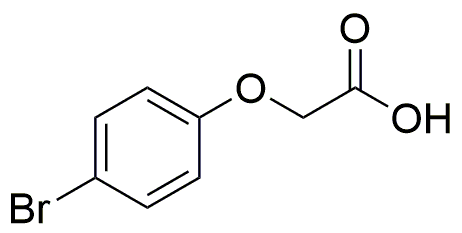4-Bromophenoxyacetic acid is widely utilized in research focused on:
- Plant Growth Regulation: This compound acts as a herbicide and plant growth regulator, helping to control unwanted vegetation in agricultural settings.
- Pharmaceutical Development: It serves as an intermediate in the synthesis of various pharmaceuticals, particularly in the development of anti-inflammatory and analgesic drugs.
- Biochemical Research: Researchers use it to study plant hormone interactions, particularly in understanding auxin transport and its effects on plant development.
- Environmental Science: The compound is applied in studies assessing the impact of herbicides on ecosystems, aiding in the development of safer agricultural practices.
- Analytical Chemistry: It is utilized as a standard in analytical methods for detecting and quantifying similar compounds in environmental samples, ensuring regulatory compliance.
General Information
Properties
Safety and Regulations
Applications
4-Bromophenoxyacetic acid is widely utilized in research focused on:
- Plant Growth Regulation: This compound acts as a herbicide and plant growth regulator, helping to control unwanted vegetation in agricultural settings.
- Pharmaceutical Development: It serves as an intermediate in the synthesis of various pharmaceuticals, particularly in the development of anti-inflammatory and analgesic drugs.
- Biochemical Research: Researchers use it to study plant hormone interactions, particularly in understanding auxin transport and its effects on plant development.
- Environmental Science: The compound is applied in studies assessing the impact of herbicides on ecosystems, aiding in the development of safer agricultural practices.
- Analytical Chemistry: It is utilized as a standard in analytical methods for detecting and quantifying similar compounds in environmental samples, ensuring regulatory compliance.
Documents
Safety Data Sheets (SDS)
The SDS provides comprehensive safety information on handling, storage, and disposal of the product.
Product Specification (PS)
The PS provides a comprehensive breakdown of the product’s properties, including chemical composition, physical state, purity, and storage requirements. It also details acceptable quality ranges and the product's intended applications.
Certificates of Analysis (COA)
Search for Certificates of Analysis (COA) by entering the products Lot Number. Lot and Batch Numbers can be found on a product’s label following the words ‘Lot’ or ‘Batch’.
Numéro de catalogue
Numéro de lot/série
Certificates Of Origin (COO)
This COO confirms the country where the product was manufactured, and also details the materials and components used in it and whether it is derived from natural, synthetic, or other specific sources. This certificate may be required for customs, trade, and regulatory compliance.
Numéro de catalogue
Numéro de lot/série
Safety Data Sheets (SDS)
The SDS provides comprehensive safety information on handling, storage, and disposal of the product.
DownloadProduct Specification (PS)
The PS provides a comprehensive breakdown of the product’s properties, including chemical composition, physical state, purity, and storage requirements. It also details acceptable quality ranges and the product's intended applications.
DownloadCertificates of Analysis (COA)
Search for Certificates of Analysis (COA) by entering the products Lot Number. Lot and Batch Numbers can be found on a product’s label following the words ‘Lot’ or ‘Batch’.
Numéro de catalogue
Numéro de lot/série
Certificates Of Origin (COO)
This COO confirms the country where the product was manufactured, and also details the materials and components used in it and whether it is derived from natural, synthetic, or other specific sources. This certificate may be required for customs, trade, and regulatory compliance.


